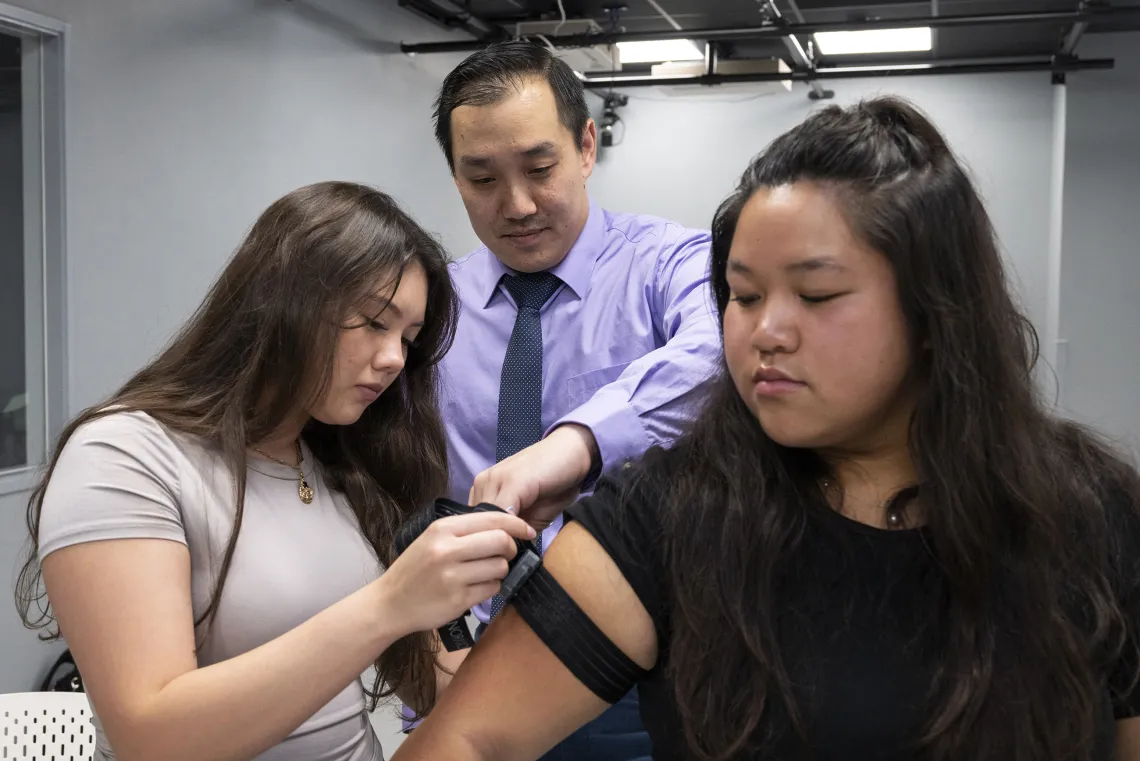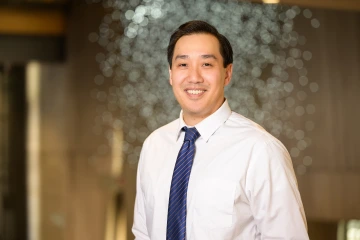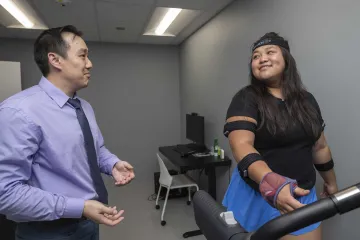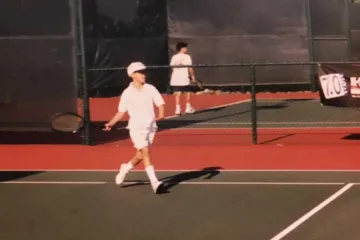Preventing falls a deeply personal mission for researcher
After seeing the debilitating effects of slips and falls on older adults, Jonathan Lee-Confer’s research focuses on strengthening the arms to lower risks.

In the U of A Health Sciences SensorLab, Jonathan Lee-Confer, PhD, helps a student fit an arm sensor on a test subject before gathering data from simulated falls.
Photo by Noelle Haro-Gomez, U of A Health Sciences Office of Communications
Jonathan Lee-Confer, PhD, exudes an air of relaxed calm. But challenge him to a game of tennis and you’ll get a peek at his competitive side.

Jonathan Lee-Confer, PhD
Photo by Kris Hanning, U of A Health Sciences Office of Communications
Lee-Confer, an assistant professor in the developing Doctor of Physical Therapy program at the University of Arizona College of Health Sciences, began playing tennis when he was 5 years old and started competing not long after.
“What I like most about tennis is that it’s an independent sport,” Lee-Confer said. “The coach doesn’t talk to you while you’re playing. That means you really have to figure things out on your own. Like, if you’re losing a point, you have to ask yourself, ‘What’s this person doing?’ It requires analysis to figure out if my opponent is doing something different or if I should be doing something different. There is a kind of mental gymnastics of trying to figure out the puzzle and seeing if you can outsmart the opponent.”
A shoulder injury when Lee-Confer was 11 forced him to get physical therapy for the first time. His physical therapist showed him how to stretch and mobilize the shoulder area, and within a few months he was playing tennis again. He played through community college, but another shoulder injury put him right back in physical therapy. Within months, he was on the court competing again.
That problem-solving mindset needed on the court is evident in his work today.
Tragedy sparks motivation
Lee-Confer studies fall prevention in older adults. While conventional research has focused on strengthening the legs to improve balance and reduce the risk of falling, Lee-Confer said he believes strengthening the arms may also be beneficial to prevent falls. He authored a perspective article for Frontiers to introduce the idea.
The conventional physical therapy approach to improve balance is to strengthen the legs, but Lee-Confer suggests that arm movements also help maintain balance during slips and falls. Getting a better understanding of how arm movements improve balance may help clinicians develop more thorough fall-prevention strategies for older adults.
The issue is deeply personal for him. When he was 22 years old, two of his uncles experienced slips and falls. One uncle fractured his hip. The other died after hitting his head on the pavement.
At the time, Lee-Confer was studying kinesiology at California State University, Sacramento, where he eventually earned bachelor’s and master’s degrees.
While volunteering as a technician in a physical therapy clinic in 2009 to gain experience, Lee-Confer worked firsthand with older patients who had fallen. There, he met an 88-year-old World War II veteran who slipped and fell on the concrete while watering his plants. The veteran told Lee-Confer he had to army-crawl across his yard to get to the back sliding door, pull it open and crawl inside before pulling his landline phone down by the cord to call 911.
“That's when I started thinking, ‘How do we stop this?’” Lee-Confer said. “I wanted to study how people fall and what we could do to stop it rather than going into the physical therapy and rehabilitation route, which focused more on what to do after falls happen.”
Falling with purpose
With a new focus on prevention, Lee-Confer decided to pursue a doctorate in biokinesiology with a biomechanics concentration at the University of Southern California.
It was during this time that he also got back into tennis, playing doubles with his lab partner. They played together in United States Tennis Association leagues all over Southern California for several years.
“We lost our first match and then won every match together after that,” he said.

Lee-Confer conducts fall simulations with a test subject fitted with sensors as she walks on a treadmill.
Photo by Noelle Haro-Gomez, U of A Health Sciences Office of Communications
For tennis players, strokes like forehands, backhands and serves require raising the arm upward, which are similar to movements older adults may make when they are slipping.
“I went into my PhD trying to figure out what the arms are doing during a fall,” he said. “We found that if you tie their arms down, people fall 300% more. We looked at it mechanically to see how arms help people regain balance. And now we’ve shown that older adults don’t move their arms as rapidly as younger adults, and they tend to lose a lot more balance because of that.”
His research seeks to determine whether the arms can be trained to move more rapidly and respond more quickly in the event of a fall. To study this, test subjects – young people for now – are fitted with sensors that are attached to a harness on a low-friction trolley system. The data collected in the U of A Health Sciences SensorLab from the simulated falls contributes to the research.
“Some people think there could be this kind of passive mechanics (during a fall), meaning that if my leg moves really quickly then my body starts to move and the energy kind of rotates and the arms might come out, so it’s passive or just a byproduct of movement,” Lee-Confer said.
“But we’re looking at the sequencing of when the legs move, when the trunk moves, when the arms move, and when do we see electrical activation of the muscles that control the arms and relate them to one another? What we’re showing is the arms recruit the muscles to move your arms way before all the legs start to even transfer energy to the trunk. The idea is that if the arms are showing there is more of an electrical connection that’s active, that can be trained.”
He said the next step would be intervention studies in which researchers train older adults how to move their arms more appropriately to reduce fall risk.
“His concept that the arm reaction might be a contributing factor really helps us as physical therapists to better understand what to include in our interventions,” said Christine Childers, PT, PhD, associate professor and founding director of the physical therapy program. “Ultimately, this could be a very simple and effective concept for physical therapists to help reduce falls.”
Thinking outside the box
After moving to Tucson during the pandemic, Lee-Confer joined the Tucson Racquet & Fitness Club to get back into tennis.

Jonathan Lee-Confer, PhD, began playing tennis competitively at an early age.
Photo courtesty of Jonathan Lee-Confer
“I was undefeated in the 2022 league at the Racquet Club,” he said with a smile.
But then injury struck again.
“I think one of the realizations of my mortality was a year and a half ago. I got tennis elbow,” he said.
That’s when he adapted and switched to table tennis.
“Ping pong is a lot less stress and strain on my arm than tennis, but it still has a lot of the same movement and strategy moving the ball around,” he said. “So, getting to play ping pong with colleagues has been quite a joy.”
The Doctor of Physical Therapy program is set to begin in fall 2025. Lee-Confer and Childers said their primary goal for the program is to produce excellent clinicians who are ready to serve their community.
“Dr. Lee-Confer strongly promotes the program to our local undergraduate students, exactly the type of individuals we are looking for who will hopefully one day want to give back to the Tucson community as a practicing physical therapist,” Childers said.
“One of the things that I’ve found as I’m getting older is that when I get injured, it’s a huge impact on my quality of life,” Lee-Confer said. “Physical therapists are a really good first line of health care providers to improve people’s quality of life. So, I want to make sure that we’re putting out clinicians who can think critically, are reflective and are serving society.”

